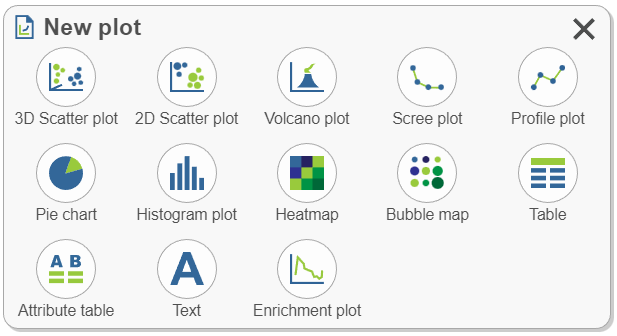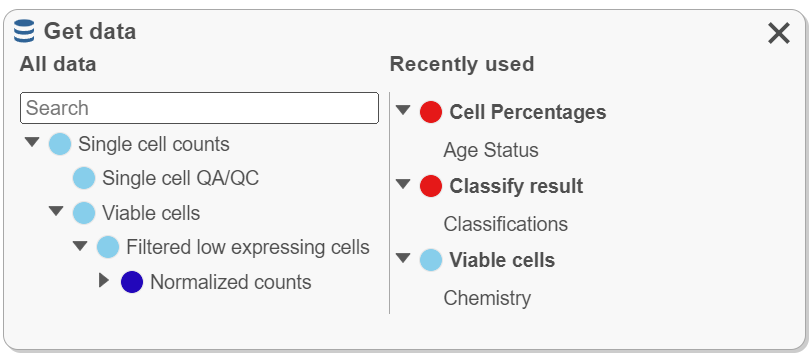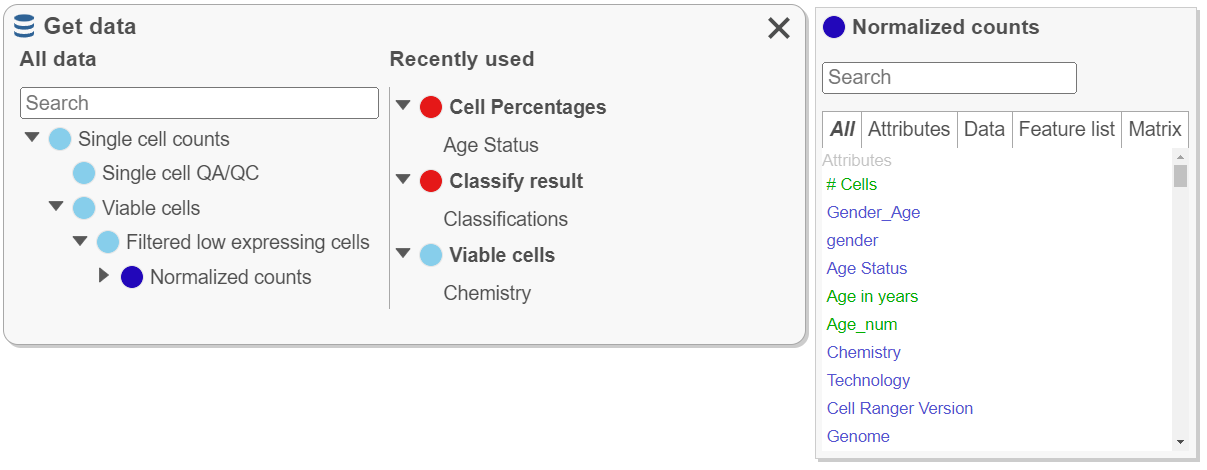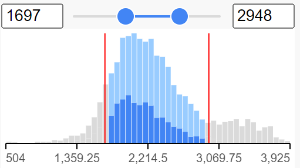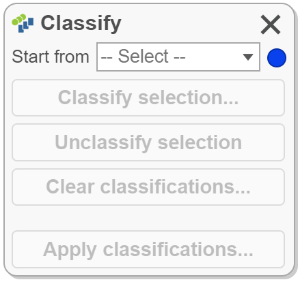Terminology
Data Viewer = a collection of sheets
Sheet = view one or more linked plots and controls
Plot = a visualization
Icon = invokes modification controls
Menu = icons located on the left side of the data viewer
Droppable = piece of data that can be dragged and dropped
Target = place to drop a droppable
Node = data results from the analysis pipeline
FAQs
Q- What is the Data viewer? A - The Data viewer is a general-purpose data visualization tool that includes 2D and 3D scatter plots, histograms, heatmaps, violin plots, and more.
Q- How is it invoked? A- Select a data node and double-click to view the task results in the Data viewer. You can also select the Data viewer tab in a project to start a new session or revisit a saved session.
Q- Can I view data from multiple data nodes? A- You can view data from different nodes in one sheet, but not in one plot.
Q- Can I open more than one icon at a time and move it around? A- Yes, open as many icons as you need at a time and move them around the screen. Click in the right corner to close the icon.
Q- Is there a recently used function? A- Yes, there is a recently used function within the Plot data icon. This lets you drag recent nodes or green droppables to blue targets.
How do I get started and navigate the data viewer?
To get started in a new data viewer session click New session or open a previously saved session. New session will prompt you to drag and drop an available plot or data node to visualize your data on the sheet; to do this, use New plot or Get data under Setup in the left menu. The menu words can be shown or hidden . The menu is organized as single-click common controls, Setup, Tools, and Configure icons. Common controls and Setup icons do not change but Tools and Configure icons will change according to the selected plot type. Icons can be open at the same time, moved around, and are closed by clicking in the right corner.
- Common controls include: Save which will overwrite a saved session and Save as which will save a new session but must be given a new name, Undo and Redo which recovers backwards and forwards actions, and Export image and Send to notebook where an image of the entire sheet (all of the plots in view) can be saved or sent to the notebook.
- Setup includes: New plot and Get data which are the icons used to make a new plot and navigate data from the analysis pipeline.
- Tools include: Select & Filter to make selections and filter selections, Classify to modify and apply selections as classifications, and Additional actions to create a feature list.
- Configure icons will change according to the plot type and will also update for each plot prior to closing the icon. Please navigate to the Configure help section below for more details.
How do I make a plot?
To make a new plot in the data viewer, use the Setup icons.
- Select a plot type with New plot . Clicking a plot type will suggest appropriate data options from results available in the analysis pipeline, then click the node of interest to add it to the sheet. Alternatively, drag and drop the plot to the sheet and continue with any additional selections.
- Select data with Get data . Choosing data will suggest appropriate plot types once the data is dragged onto the sheet. Note that All data nodes (left) follow the hierarchy used in the analysis pipeline while Recently used (right) nodes are updated according to recent use and can similarly be used to plot data.
- Note the blue targets when dragging data. In the case presented below, a data node, chosen from Get data, is being placed onto the sheet and it can be placed on the Top, Right, Bottom, Left, or Replace the heatmap. Once dropped to the target, a plot type must be chosen.
Can you have multiple plots on the sheet?
Yes, build them together.
- All of the plots are interactive.
- All of the plots are from the same data project.
- Selection (on the right side of individual plots and in the menu ) and filtering options are linked for the plots on the sheet. Clear filters in the Select & Filter mode to remove selections.
- Save plots together from the menu or independently within each plot .
When there are multiple plots, how are they controlled and configured?
- Each plot has its own window; plot windows can be resized by dragging the edge of the plot.
- Click a plot window to make it active (a dark gray border will appear for the window); the Configure icons will show settings for the active plot.
- When more than one plot is open on a sheet, plots can be rearranged by dragging from one position to another , duplicated , enter full screen, and exit full screen.
- If multiple plot types are selected together with ctrl-click or shift-click, only the plot configuration controls that are shared will be available to use.
- Select & Filter applies to all of the plots on the sheet.
- Controls are located in the same place for each plot, either in the menu on the left, the top of the plot, or the right side of the plot. Even though each plot type has its own available controls that will vary, common controls such as those available above Setup in the menu: Save , Save as , Undo , Redo , Export image ,and Send to notebook , and and at the top of the plot: Hide controls, Show controls, Click and drag to move the plot, Duplicate, Export image, Send to notebook, enter Full screen, exit Full screen, and Remove plot will remain the same.
My screen is full of plots. How do I add more plots without starting a new data viewer session?
Multiple sheets (where plots are added) are allowed in the data viewer. This is helpful when you cannot fit more plots on the sheet (screen) but you still want to use all of the settings that you are working with (e.g. recently used).
- Sheet navigation uses a panel at the bottom of the screen . Use to Add a sheet or the to Duplicate, Rename, or Delete a sheet.
Why does some data light up green when I hover over it?
Any data that lights up with a green background when hovered over can be dragged, and dropped onto a blue target .
- This includes legend, axis titles, criteria used in Select & Filter, and features in tables. Any data present in Plot data will light up green to be dragged to make a plot.
- Drag and drop manipulation is also possible for data nodes present in the configure icons (e.g. Axes and Style).
How do I color my plot by a gene?
There are multiple ways to color plots by a gene or protein (feature) of interest. You can also color by more than one feature on the same plot or even feature lists. You can also choose to represent a feature with styles other than color, like shape or size.
- Drag and drop the gene of interest from the appropriate node in Get data (e.g. normalized counts). The Recently used list can be helpful for this if you have already recently used the gene.
- Open the Style icon and change Color by. Make sure you are on the appropriate node . Some plot types (e.g. tSNE) will invoke Style by clicking the legend. This is where you would color by a feature list that you have saved under list management.
- Drag and drop features from another plot on the sheet (e.g. an axis title from a violin plot) or drag and drop features from criteria added to the Select & Filter icon.
Can I plot genes from tables without going back to the analysis pipeline?
Yes, report results such as those generated from differential analysis can be navigated to in the data viewer and specific genes can be plotted.
- The tables must be plotted on the sheet. One way to do this is to choose New plot , select Table (only data in table format are available), and select the data of interest to plot. Features (green with hover) are now available for drag and drop to the plot type of interest.
How do I manipulate my plot without using Tools or Configure?
- Selections can be made directly on the plot . This can include selecting populations of cells or selecting genes of interest (e.g. to classify clusters of cells). The menu must still be used to filter , classify , and create gene lists after in-plot selection.
- Clicking on the Legend will invoke configure options. The configure options invoked will vary depending on the plot type.
- Clicking the axis titles will invoke the axes configuration.
Setup
New plot
- Click a plot type. Choosing a plot type will suggest appropriate data options from results available in the analysis pipeline. The search bar can be used to navigate to a specific node of interest (e.g. normalized). Select a data node to add it to the sheet.
- Alternatively, drag and drop the plot to the sheet (blue targets) and continue with any additional selections.
Get Data
All data results from building the analysis pipeline are found here. This icon is used to create plots, to plot attributes and features of interest (e.g. color a plot by a gene of interest from the normalized data node), and to plot Recently used data nodes and droppables.
Find the data node by expanding the pipeline or use the Search bar to quickly locate results.
- To create a plot, drag the node to the sheet and continue with additional selections.
- Recently used (right side) data is organized according to the node from which it is derived and will update according to recent use. If the data viewer session is saved, recently used will be saved.
- Click a node under All data to search data found within that node such as attributes, genes, or lists. Drag data (green droppable) to blue targets (e.g. search the normalized counts node for a gene then drag the gene to color a tSNE plot). Numeric attribute names (e.g # cells) are green while categorical attribute names (e.g. classifications) are blue.
Tools
Select & Filter
This icon is where selections are made (left side) and filtered (right side). Selecting and filtering will be applied to all plots in the sheet. Selections can be used to filter and/or classify . Selections used to filter can be named under classify and indicate the number of cells included.
- Deselected points (the points that are not selected) can either be Dim (colors are not as bright) or Gray (not colored but instead gray)
- There are two selection modes: Manual and Criteria.
- Manual
- Manual governs in plot selections which can undergo filtering or classification.
- Criteria
- Criteria allows additions according to the selected node (this is criteria used to configure the plot like attributes or genes).
- Data can be dragged directly to Add criteria to generate selections or use the drop-down.
- When criteria are added, the icon will grow with the selections. Remove the selections by clicking .
- Selections can be dragged to blue targets.
- Each criteria can be modified. Invert can be used to include or exclude selections. When modifying criteria by low or high values, pin histogram lets you see multiple histograms at a time. Histograms are colored according to selections: the dark blue is what’s being selected for, the gray is the data outside the current selection (i.e. the positions of the slider handles), and the light blue is data that is within the slider’s selected region but is currently deselected by other selection criteria.
- Manual
- Filter
- Click to include the selected points, click to exclude the selected points, and click to remove filters.
- Apply observation filter and Apply feature filter are used to apply filters to data nodes in the analysis pipeline.
Classify
The Classify icon holds draft classifications to be applied or saved classifications that can be opened, applied, and refined as necessary then saved again as a new classification. Classification names can be edited and the Classifications can be deleted. The number of points in the classification are listed and will be updated accordingly with any changes. Classify selection requires a label (name) and will overwrite the previous applied classification if the points have already been classified. Apply classifications can be used to apply the classification to a data node.
Additional actions
The Additional actions icon holds other available plot actions. This icon will become available for applicable plot types (e.g. heatmap). Currently, it is used to Create a feature list.
Configure
These are the configuration options for plots. Open as many icons as you need and move them around the screen then click in the right corner to close the icon when finished. Changes will automatically be saved before closing and will not affect other plots unless both windows are selected and modified together. If an icon is opened from a plot and kept on the screen but not available for use in a different type of plot, you will be notified that the configuration is not available for the selected plot.
Description
- Click the Title on a plot or choose the Description icon from the menu.
- This contains Title and Legend settings.
Axes
- Click the Axes icon from the menu. The axes dialogue can also be opened by clicking the X, Y, or Z axis titles.
- The available options change depending on the plot type.
- Features and attributes can be dragged to the Axes card . Alternatively, drag feature and attributes from the axis to plots using the data node .
Data
- Data configuration options frequently change for different plot types. See the examples below.
Style
- Style can be invoked from the menu or by clicking the Legend of most plot types.
- This is where Color, Size, Shape, Labeling, and Style (bar or line) settings are found.
Grouping
- Grouping is only invoked from the menu.
- This is where you split, connect, and highlight by data.
Statistics
- Statistics is invoked in the menu.
- It is used for Analytics (regression line) and to modify plot Significance.
Background
- The Background can be modified for some ploy types; this setting is found in the menu.
- PNG, JPG, and BMP files are supported by all major web browsers. Your browser may support additional formats.
Control
- Control is used for 3D scatter plots and found in the menu.
- This is where settings for moving the 3D plot are found.
Heatmap & Bubble map
Please see Hierarchical Clustering Configuration Settings for details related to configuring a heatmap or bubble map in the data viewer.
Additional Assistance
If you need additional assistance, please visit our support page to submit a help ticket or find phone numbers for regional support.


| Your Rating: |
    
|
Results: |
    
|
0 | rates |

